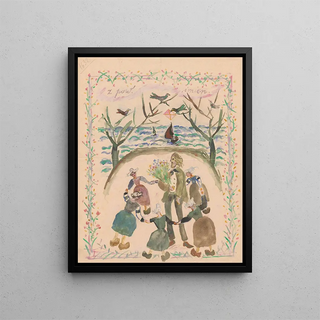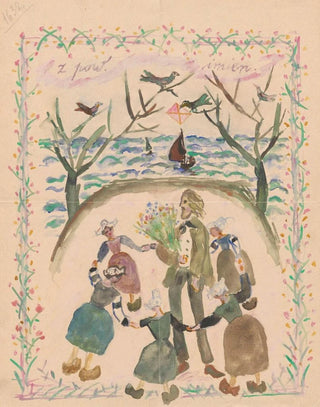Art print | Festive card for Maria Mickiewiczówna - Tadeusz Makowski


View from behind

Frame (optional)
Art print of a festive card for Maria Mickiewiczówna - Tadeusz Makowski – Captivating introduction
In the vast panorama of art history, some works stand out for their ability to capture not only a scene but also an emotion, an atmosphere. "Festive card for Maria Mickiewiczówna" by Tadeusz Makowski is one of those creations that, through its apparent simplicity, invites deeper reflection. This piece, evoking an intimate celebration, is imbued with Polish culture and the artistic influences of its time. Contemplating this work, the viewer is transported into a universe where joy and lightness blend with nostalgia, thus revealing the very essence of Makowski's art.
Style and uniqueness of the work
Tadeusz Makowski's style is often characterized by a delicate and poetic approach to painting. In "Festive card for Maria Mickiewiczówna," he combines elements of Impressionism and Post-Impressionism, creating a dialogue between light and color. The pastel shades dominating the composition evoke softness and serenity, while the way figures are arranged on the canvas demonstrates remarkable mastery of space. Each character seems to live a moment of grace, as if suspended in time. The composition, both balanced and dynamic, draws the eye and invites exploration of the meticulous details that enrich the work. The lightness of forms and the fluidity of lines testify to an artistic sensitivity that transcends simple representations to touch on the universal.
The artist and his influence
Tadeusz Makowski, born in Poland in 1882, is an artist whose work is marked by a quest for identity and beauty. Influenced by the great masters of European painting, he develops a unique style that combines tradition and modernity. His career, although relatively short, is punctuated by significant artistic encounters and travels that enrich his visual language. Makowski is also an active member of his era's artistic community, participating in exhibitions and movements seeking to redefine Polish art. His ability to incorporate folk elements into his work, while drawing inspiration from the currents

Matte finish

View from behind

Frame (optional)
Art print of a festive card for Maria Mickiewiczówna - Tadeusz Makowski – Captivating introduction
In the vast panorama of art history, some works stand out for their ability to capture not only a scene but also an emotion, an atmosphere. "Festive card for Maria Mickiewiczówna" by Tadeusz Makowski is one of those creations that, through its apparent simplicity, invites deeper reflection. This piece, evoking an intimate celebration, is imbued with Polish culture and the artistic influences of its time. Contemplating this work, the viewer is transported into a universe where joy and lightness blend with nostalgia, thus revealing the very essence of Makowski's art.
Style and uniqueness of the work
Tadeusz Makowski's style is often characterized by a delicate and poetic approach to painting. In "Festive card for Maria Mickiewiczówna," he combines elements of Impressionism and Post-Impressionism, creating a dialogue between light and color. The pastel shades dominating the composition evoke softness and serenity, while the way figures are arranged on the canvas demonstrates remarkable mastery of space. Each character seems to live a moment of grace, as if suspended in time. The composition, both balanced and dynamic, draws the eye and invites exploration of the meticulous details that enrich the work. The lightness of forms and the fluidity of lines testify to an artistic sensitivity that transcends simple representations to touch on the universal.
The artist and his influence
Tadeusz Makowski, born in Poland in 1882, is an artist whose work is marked by a quest for identity and beauty. Influenced by the great masters of European painting, he develops a unique style that combines tradition and modernity. His career, although relatively short, is punctuated by significant artistic encounters and travels that enrich his visual language. Makowski is also an active member of his era's artistic community, participating in exhibitions and movements seeking to redefine Polish art. His ability to incorporate folk elements into his work, while drawing inspiration from the currents






